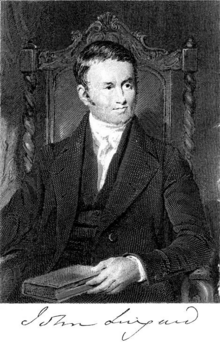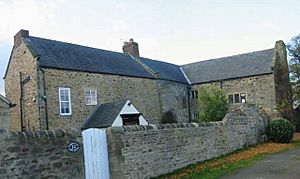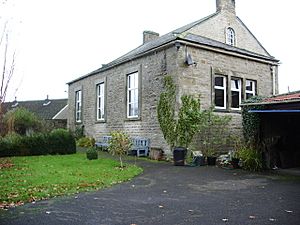John Lingard facts for kids
Quick facts for kids
John Lingard
|
|
|---|---|
 |
|
| Born | 5 February 1771 St. Thomas Street, Winchester, England
|
| Died | 17 July 1851 (aged 80) |
| Scientific career | |
| Institutions |
|
John Lingard (born February 5, 1771 – died July 17, 1851) was an English Catholic priest and a very important historian. He wrote a famous eight-book series called The History of England. This huge work covered English history from the time the Romans first arrived until King Henry VIII became king. John Lingard also taught at schools like the English College at Douai and Crook Hall. Later, he moved to Hornby in Lancashire to focus on his writing.
Contents
John Lingard's Early Life and Education
John Lingard was born in 1771 in Winchester, England. His parents, John and Elizabeth Lingard, were recusants. This meant they were Catholics who refused to attend Church of England services. His mother's family had faced difficulties because of their Catholic faith. His father, a carpenter, became Catholic when he married.
When John was young, Bishop Challoner suggested he go to the English College in Douai, France. John started there in September 1782 to train as a priest. He was very good at his studies, especially in humanities and theology.
Escaping the French Revolution
During the French Revolution, things became dangerous in France. When Britain and France declared war, John Lingard had to escape. In 1793, he returned to England. He helped two brothers and William Stourton get back safely. For almost a year, he worked as a tutor for young William Stourton near York.
John Lingard soon learned that some of his students from Douai were at a school in Tudhoe. He asked to join them, and his request was granted.
In 1794, Bishop William Gibson asked Thomas Eyre to look after the students from Douai. These students were first at Tudhoe with Lingard. Mr. Eyre moved Lingard and his students to Pontop Hall, and then later to Crook Hall. Both places were near Durham. Lingard became a professor of philosophy there. He also helped manage the college and taught Church history.
Becoming a Priest and Author
John Lingard finished his studies and became a priest in York in April 1795. In 1805, he wrote a series of letters. These letters were later published as a book called Catholic Loyalty Vindicated. In 1806, his first book, The Antiquities of the Anglo-Saxon Church, was published. This book grew out of talks he had given.
He stayed at Crook Hall for 14 years. In 1808, the seminary moved to St. Cuthbert's College. Lingard even donated a beautiful stained glass window to the chapel there.
After Mr. Eyre died in 1810, Lingard took charge of the college. He also continued teaching theology. In 1811, he decided to retire from teaching. He moved to a quiet mission in Hornby, near Lancaster. He was offered leadership roles at other colleges, but he turned them down.
John Lingard's Major Works
In 1819, the first three books of his most famous work, The History of England, were published. The first book was originally meant to be a textbook for schools. In 1821, Pope Pius VII honored Lingard by making him a Doctor of Divinity. A fourth book came out in 1823, covering history up to the time of Edward VI.
Lingard used the money from his fourth book to build St. Mary's Church in Hornby. He jokingly called it "Henry VIII's Chapel." This church is now a Grade II listed building, meaning it's historically important. In 1825, he traveled to Rome for research. Pope Leo XII gave him a special gold medal. He kept publishing more books in his History of England series until he finished the whole work in 1849.
The Antiquities of the Anglo-Saxon Church
Lingard's book The Antiquities of the Anglo-Saxon Church came from talks he gave. It was published in 1806. Lingard made sure to use original sources for his information. He showed how the church in England grew alongside the country's political system. He also highlighted how many Catholic traditions, thought to be "Romish" by some, were actually brought to Europe by Englishmen. By connecting Anglo-Saxon Christians to Catholics of his time, he wanted to show that Catholics were loyal Englishmen.
The History of England
The main goal of his big work, The History of England, was to show the difficult effects of the English Reformation. As more books in the series came out, its reputation grew. Lingard kept updating and improving the entire work. He used most of the money he earned from his books to help students become priests.
Lingard wrote his history in a very fair way. He didn't even mention on the title page that he was a priest. He wanted to write an unbiased history. This fair approach actually helped his Catholic viewpoint. It showed Catholics as reasonable and tolerant, making their opponents seem prejudiced.
Lingard believed that a historian's most important job was:
- "to carefully check the sources they use."
- "to watch out for their own personal feelings and ideas."
He said that if a historian doesn't do this, they might "sacrifice the truth for their own group's interests."
Lingard chose a calm approach to history. He focused on clear facts and used original documents instead of other historians' interpretations. In The History, Lingard wanted to convince Protestants about the basic truths of the Catholic faith. But he did this while keeping his history unbiased. He hoped his book would be read by Protestants. In a letter from 1819, he wrote: "My only chance of being read by Protestants depends upon my having the reputation of a temperate writer."
Lingard's Catholic faith also helped him be an impartial historian. It kept him separate from the strong nationalism that influenced many Protestant historians. His careful research and use of original sources were groundbreaking. He was the first British historian to use many Vatican archives and other European documents. This made his work very detailed and accurate.
The most common version of The History has 10 books. It covers history up to William and Mary becoming rulers in 1688. There's also a larger 13-book version that was his final update. His History was later shortened and used as a textbook in English Catholic schools.
Later Life and Legacy
Lingard also translated the Four Gospels (parts of the Bible) in 1836. He used early Greek texts instead of the usual Latin version. This was a bit unusual for a Catholic at the time.
William Cobbett used Lingard's history as a fair source for his own book, History of the Protestant Reformation. Cobbett argued that the Reformation had very bad effects on ordinary English people. Lingard's work helped prepare the public to accept the Catholic Emancipation Bill, which gave Catholics more rights.
John Lingard did not receive much official recognition from the British academic world. However, his History of England was a very important scholarly work. It gave a full and detailed account of English history. From 1811 until his death in 1851, Lingard lived quietly in Hornby. He spent his time studying and writing. He was a kind and gentle man, well-liked by everyone in the village.
While Lingard's popularity as a historian might have faded over time, his contributions to how history is studied were very important. The fact that he was a Catholic priest during a difficult time for the Church in England makes his work even more interesting.
In 1821, Pope Pius VII gave Lingard three doctorates: in theology, canon law, and civil law. A few years later, Pope Leo XII gave him a gold medal. This medal was usually only given to cardinals and princes.



